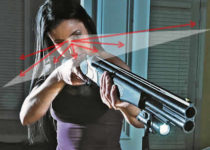
Do you know Situational Awareness?
Situational awareness is the perception of environmental elements which translate to being aware of your surrounding.
This is important for being prepared to defend yourself and your family. Which is becoming more important these days.
Having this edge can make a differences in your decision making while in a fight or avoiding one.
We don’t necessary have to train to be a Ninja to one with nature, but that is the idea.
Don’t view this as 007 fantasy or paranoia, but just heighten alertness as part of your lifestyle.

Its true that we train for the worse case scenario to shoot while in a gunfight. But we should train our awareness more which can help us better at employing those shooting skills.
Being aware and observant is using your eyes and hearing your mind is looking for those red flags in your environment.
Many soldiers and combat veterans in general come back still in an “orange” state of readiness, which finds themselves always looking around. Its an adjustment from a war environment to a quiet domestic one.
This situational awareness is ingrained into them while on these hot deployments.
Here’s a primer on security for the newbie and refresher for veterans.
Security Setup
One of the things that is taught at the basic level for soldiers is security. You may find this to be very common to LE and regular security functions.
Soldiers are taught that security is 360 degrees and 100% of the time.
- Which means that your entire surroundings are a threat and you need to watch them.
- This is to help with spotting a threat before it has a chance to hurt you.
- When you are watching your surroundings it is important that you keep quiet and quickly scan your surroundings with intense attention to detail.
- Watch the little things like the location of hands, where eyes are pointed, how people carry themselves, what they are wearing, etc.
- There is also location scanning that you must be aware of like sources of sound, camera locations, blind spots, locations of exits/entrances, etc.
- No detail is too small when you are looking around, and you need to be very thorough in your visual scanning.
Scanning Methods
When looking around, there are four positions that you can use for aiming your head.
The first two are 45 degrees to the left and right which will give you a little more than 180 degrees of coverage your eyes.
The other two are looking over the shoulders which cover your rear quadrants.
This is a very obvious method of checking your rear.
Looking around can be as discrete or as obvious as you wish.
Employing peripheral scanning in public is the best method when you don’t want to make it obvious that you’re watching.
If I want to look behind me, I will walk past something and pretend to have passing interest in it and use that split second to glance at what is behind me.
I highly advise that you not stare since that is all it can take to start a conflict.
Listening
Listening to your surroundings is an invaluable skill to use and develop and is just as important as using your eyes.
Gives us good perception of our surroundings such as distance of the source of noise.
Being quiet and tuned into our surroundings in order to hear those little things that normally go unnoticed as background noise by others.
You can learn a lot about your surroundings by just listening to the different sounds.
You will find that obnoxious noises will attract attention from everyone, such as a loud rattling cart in the store, revving engines, or crying children. You have to learn to analyze every sound and judge their origin.
Its possible to use your hearing to cover most of what goes on behind you. This isn’t always feasible, but it is an added method of security that must be used in conjunction with your sight.
With these two senses alone, you can have a pretty good defense from your surroundings. If you take your safety and your families’ safety seriously, you will maintain your situational awareness. There is little to no disadvantages to this, unless you are the one whipping your head around from side to side with your hood up.
You can be very discrete and inconspicuous to those around you by using your peripherals and quick passing visuals in order to acquire your visual information.
The important thing to remember is that it is not being paranoid, it is being aware and alert to activity around you. Yes, is is a lifestyle. This is probably the most important thing you can practice if you want to give yourself the best chance of surviving any altercation.
by David Donchess and revised by ASJ Staff



